sensor Mercury Grand Marquis 2009 s User Guide
[x] Cancel search | Manufacturer: MERCURY, Model Year: 2009, Model line: Grand Marquis, Model: Mercury Grand Marquis 2009Pages: 270, PDF Size: 1.95 MB
Page 118 of 270
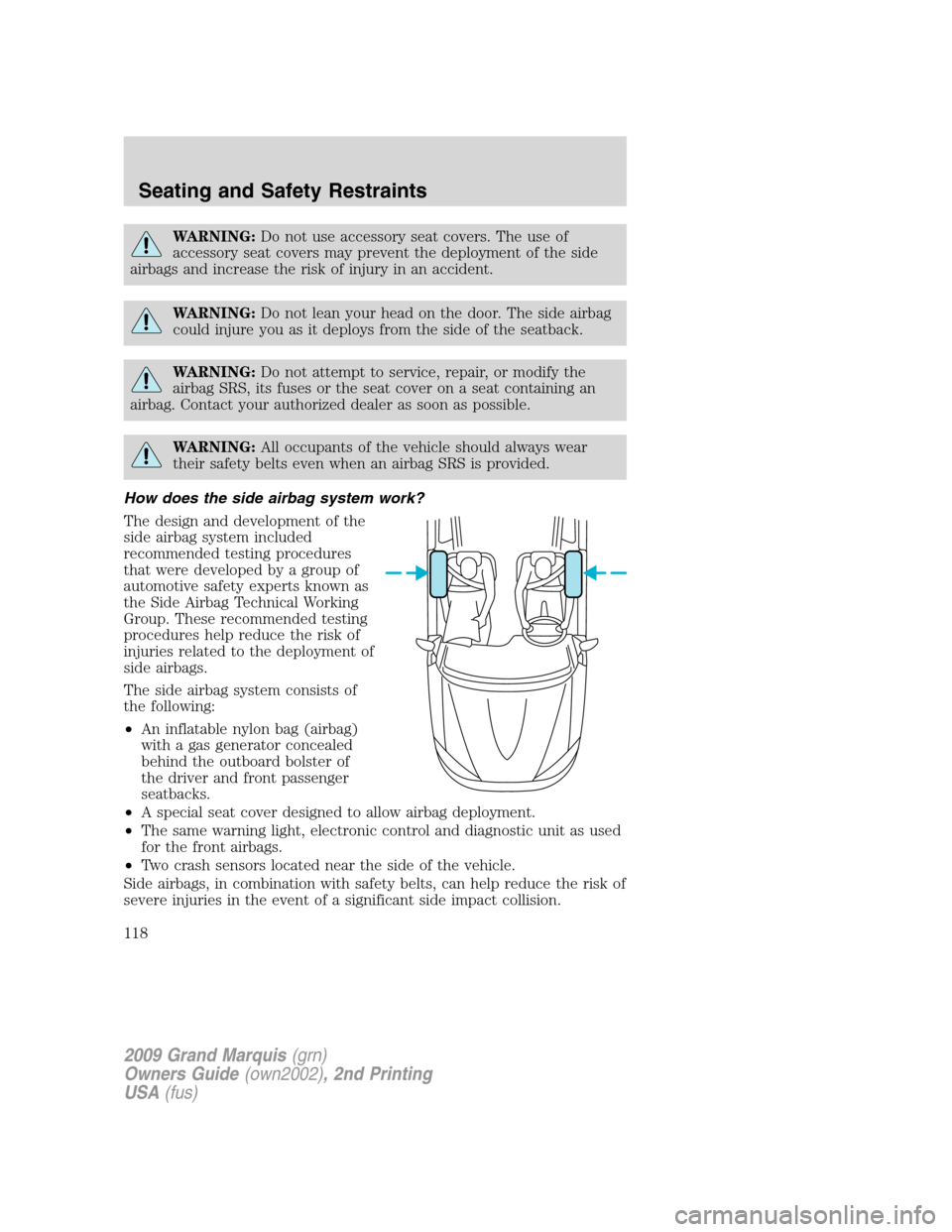
WARNING:Do not use accessory seat covers. The use of
accessory seat covers may prevent the deployment of the side
airbags and increase the risk of injury in an accident.
WARNING:Do not lean your head on the door. The side airbag
could injure you as it deploys from the side of the seatback.
WARNING:Do not attempt to service, repair, or modify the
airbag SRS, its fuses or the seat cover on a seat containing an
airbag. Contact your authorized dealer as soon as possible.
WARNING:All occupants of the vehicle should always wear
their safety belts even when an airbag SRS is provided.
How does the side airbag system work?
The design and development of the
side airbag system included
recommended testing procedures
that were developed by a group of
automotive safety experts known as
the Side Airbag Technical Working
Group. These recommended testing
procedures help reduce the risk of
injuries related to the deployment of
side airbags.
The side airbag system consists of
the following:
•An inflatable nylon bag (airbag)
with a gas generator concealed
behind the outboard bolster of
the driver and front passenger
seatbacks.
•A special seat cover designed to allow airbag deployment.
•The same warning light, electronic control and diagnostic unit as used
for the front airbags.
•Two crash sensors located near the side of the vehicle.
Side airbags, in combination with safety belts, can help reduce the risk of
severe injuries in the event of a significant side impact collision.
2009 Grand Marquis(grn)
Owners Guide(own2002), 2nd Printing
USA(fus)
Seating and Safety Restraints
118
Page 119 of 270
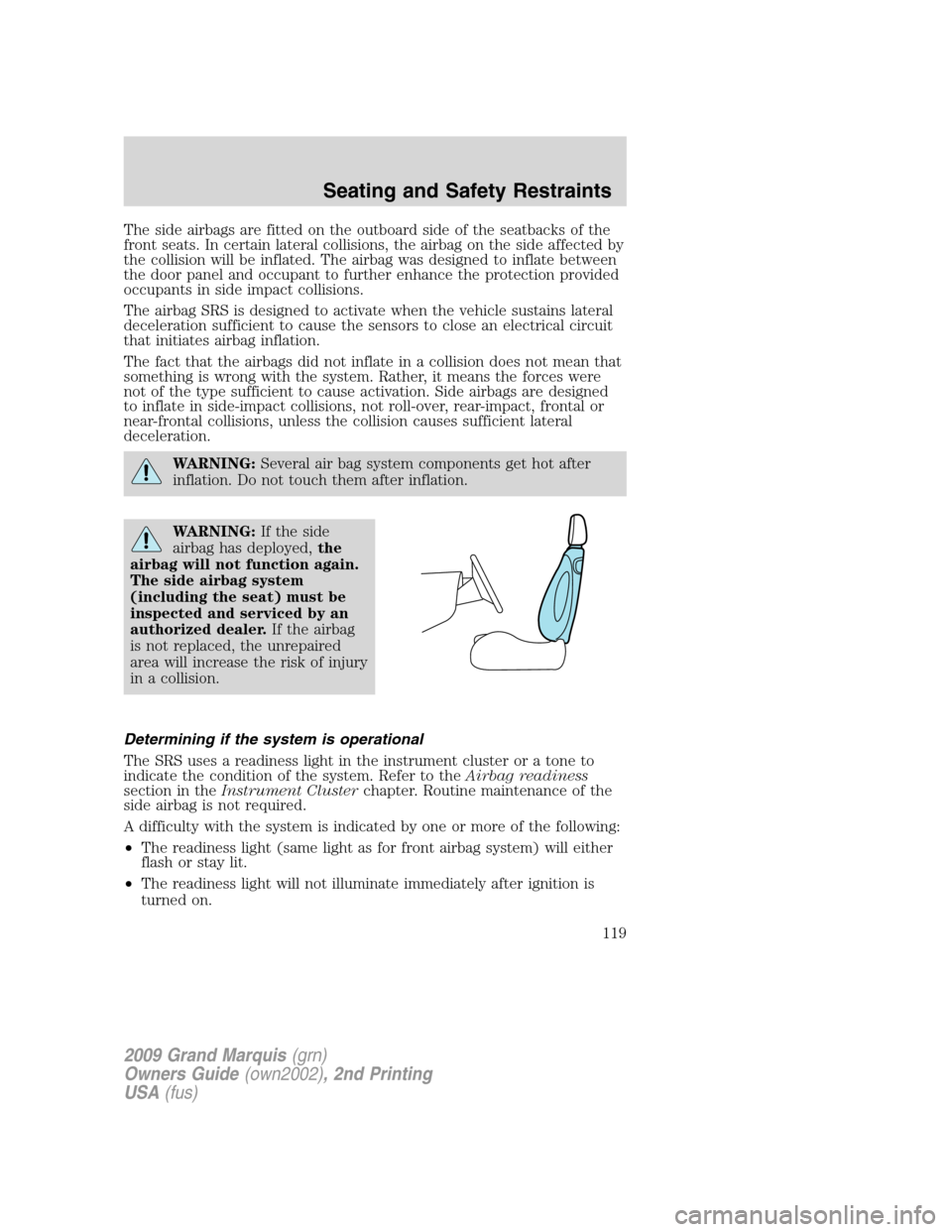
The side airbags are fitted on the outboard side of the seatbacks of the
front seats. In certain lateral collisions, the airbag on the side affected by
the collision will be inflated. The airbag was designed to inflate between
the door panel and occupant to further enhance the protection provided
occupants in side impact collisions.
The airbag SRS is designed to activate when the vehicle sustains lateral
deceleration sufficient to cause the sensors to close an electrical circuit
that initiates airbag inflation.
The fact that the airbags did not inflate in a collision does not mean that
something is wrong with the system. Rather, it means the forces were
not of the type sufficient to cause activation. Side airbags are designed
to inflate in side-impact collisions, not roll-over, rear-impact, frontal or
near-frontal collisions, unless the collision causes sufficient lateral
deceleration.
WARNING:Several air bag system components get hot after
inflation. Do not touch them after inflation.
WARNING:If the side
airbag has deployed,the
airbag will not function again.
The side airbag system
(including the seat) must be
inspected and serviced by an
authorized dealer.If the airbag
is not replaced, the unrepaired
area will increase the risk of injury
in a collision.
Determining if the system is operational
The SRS uses a readiness light in the instrument cluster or a tone to
indicate the condition of the system. Refer to theAirbag readiness
section in theInstrument Clusterchapter. Routine maintenance of the
side airbag is not required.
A difficulty with the system is indicated by one or more of the following:
•The readiness light (same light as for front airbag system) will either
flash or stay lit.
•The readiness light will not illuminate immediately after ignition is
turned on.
2009 Grand Marquis(grn)
Owners Guide(own2002), 2nd Printing
USA(fus)
Seating and Safety Restraints
119
Page 145 of 270
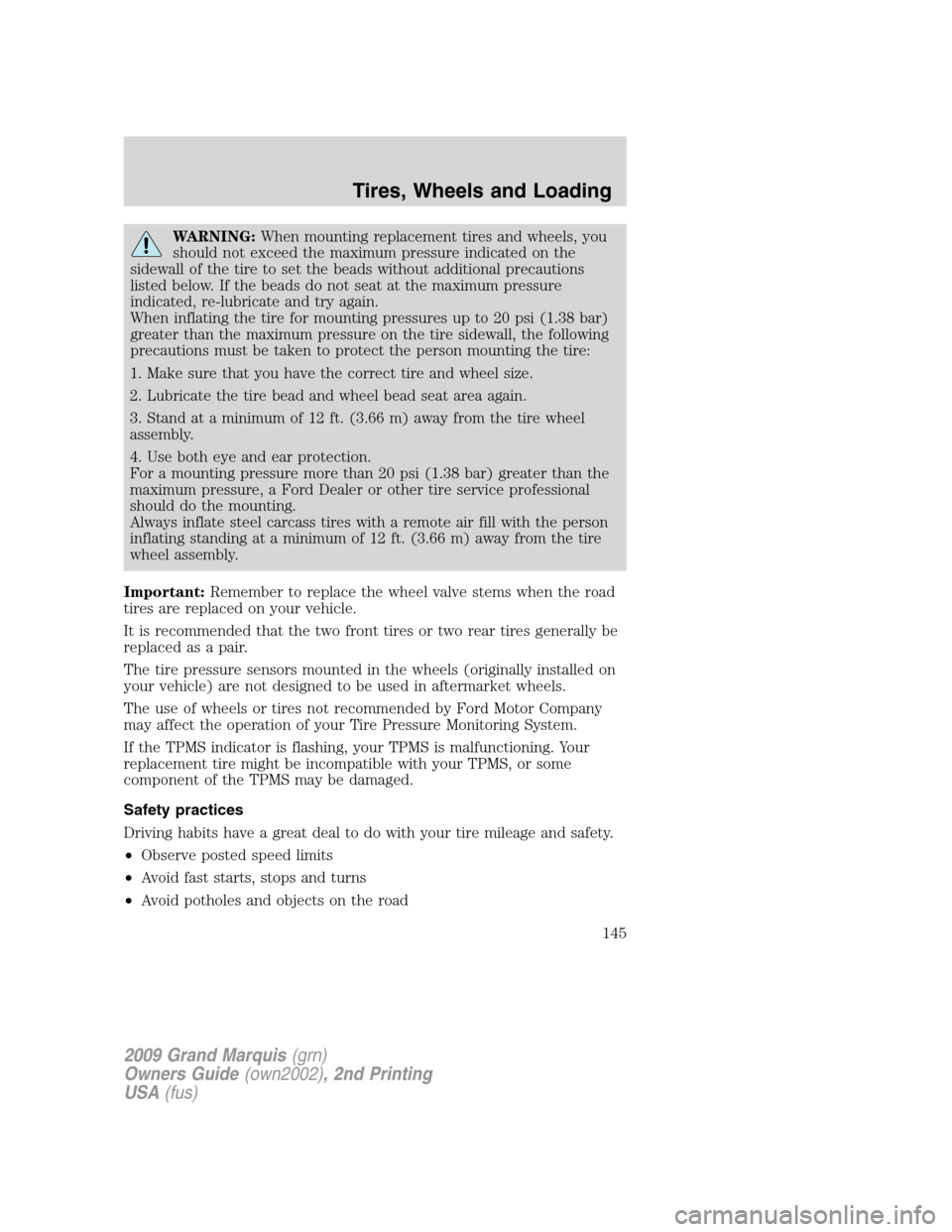
WARNING:When mounting replacement tires and wheels, you
should not exceed the maximum pressure indicated on the
sidewall of the tire to set the beads without additional precautions
listed below. If the beads do not seat at the maximum pressure
indicated, re-lubricate and try again.
When inflating the tire for mounting pressures up to 20 psi (1.38 bar)
greater than the maximum pressure on the tire sidewall, the following
precautions must be taken to protect the person mounting the tire:
1. Make sure that you have the correct tire and wheel size.
2. Lubricate the tire bead and wheel bead seat area again.
3. Stand at a minimum of 12 ft. (3.66 m) away from the tire wheel
assembly.
4. Use both eye and ear protection.
For a mounting pressure more than 20 psi (1.38 bar) greater than the
maximum pressure, a Ford Dealer or other tire service professional
should do the mounting.
Always inflate steel carcass tires with a remote air fill with the person
inflating standing at a minimum of 12 ft. (3.66 m) away from the tire
wheel assembly.
Important:Remember to replace the wheel valve stems when the road
tires are replaced on your vehicle.
It is recommended that the two front tires or two rear tires generally be
replaced as a pair.
The tire pressure sensors mounted in the wheels (originally installed on
your vehicle) are not designed to be used in aftermarket wheels.
The use of wheels or tires not recommended by Ford Motor Company
may affect the operation of your Tire Pressure Monitoring System.
If the TPMS indicator is flashing, your TPMS is malfunctioning. Your
replacement tire might be incompatible with your TPMS, or some
component of the TPMS may be damaged.
Safety practices
Driving habits have a great deal to do with your tire mileage and safety.
•Observe posted speed limits
•Avoid fast starts, stops and turns
•Avoid potholes and objects on the road
2009 Grand Marquis(grn)
Owners Guide(own2002), 2nd Printing
USA(fus)
Tires, Wheels and Loading
145
Page 154 of 270
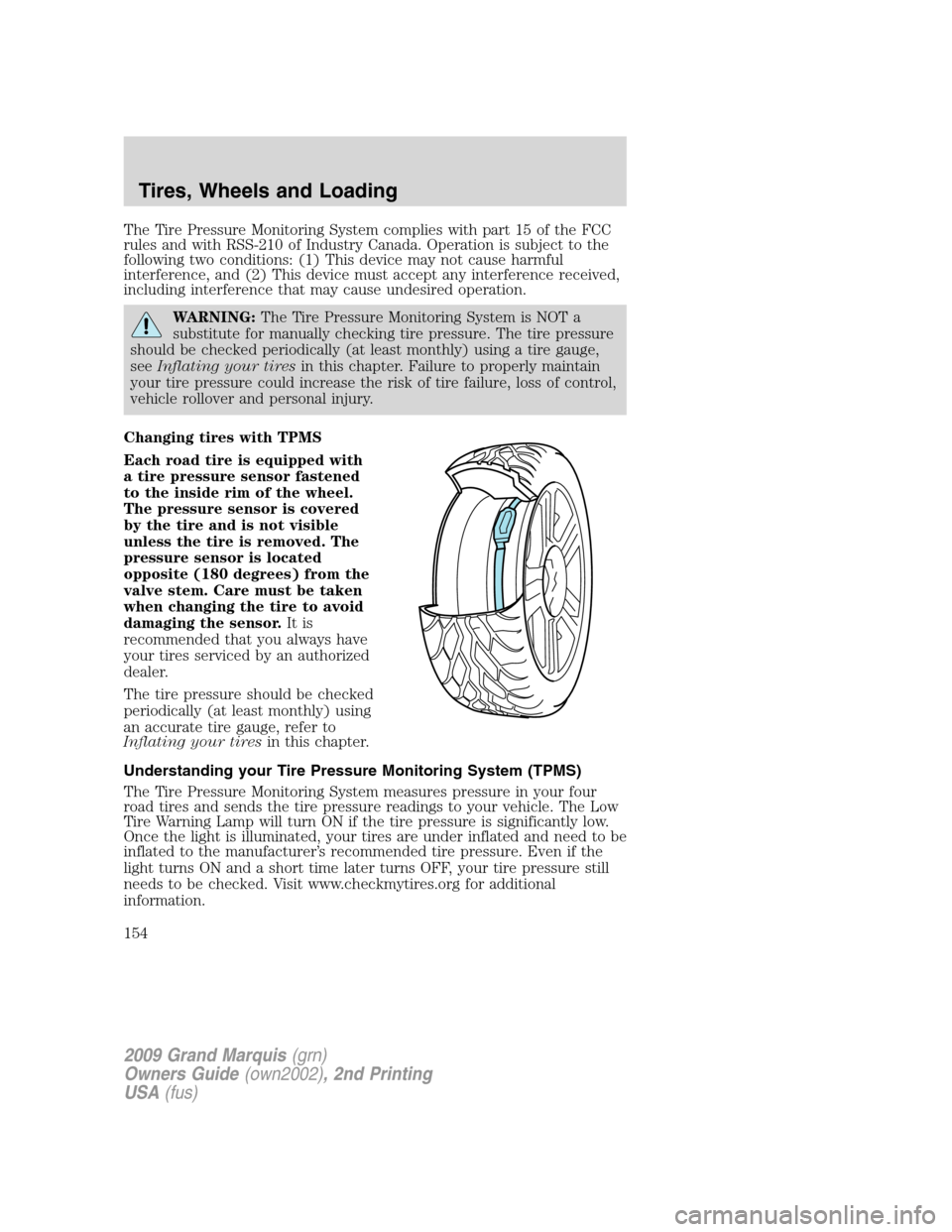
The Tire Pressure Monitoring System complies with part 15 of the FCC
rules and with RSS-210 of Industry Canada. Operation is subject to the
following two conditions: (1) This device may not cause harmful
interference, and (2) This device must accept any interference received,
including interference that may cause undesired operation.
WARNING:The Tire Pressure Monitoring System is NOT a
substitute for manually checking tire pressure. The tire pressure
should be checked periodically (at least monthly) using a tire gauge,
seeInflating your tiresin this chapter. Failure to properly maintain
your tire pressure could increase the risk of tire failure, loss of control,
vehicle rollover and personal injury.
Changing tires with TPMS
Each road tire is equipped with
a tire pressure sensor fastened
to the inside rim of the wheel.
The pressure sensor is covered
by the tire and is not visible
unless the tire is removed. The
pressure sensor is located
opposite (180 degrees) from the
valve stem. Care must be taken
when changing the tire to avoid
damaging the sensor.It is
recommended that you always have
your tires serviced by an authorized
dealer.
The tire pressure should be checked
periodically (at least monthly) using
an accurate tire gauge, refer to
Inflating your tiresin this chapter.
Understanding your Tire Pressure Monitoring System (TPMS)
The Tire Pressure Monitoring System measures pressure in your four
road tires and sends the tire pressure readings to your vehicle. The Low
Tire Warning Lamp will turn ON if the tire pressure is significantly low.
Once the light is illuminated, your tires are under inflated and need to be
inflated to the manufacturer’s recommended tire pressure. Even if the
light turns ON and a short time later turns OFF, your tire pressure still
needs to be checked. Visit www.checkmytires.org for additional
information.
2009 Grand Marquis(grn)
Owners Guide(own2002), 2nd Printing
USA(fus)
Tires, Wheels and Loading
154
Page 188 of 270
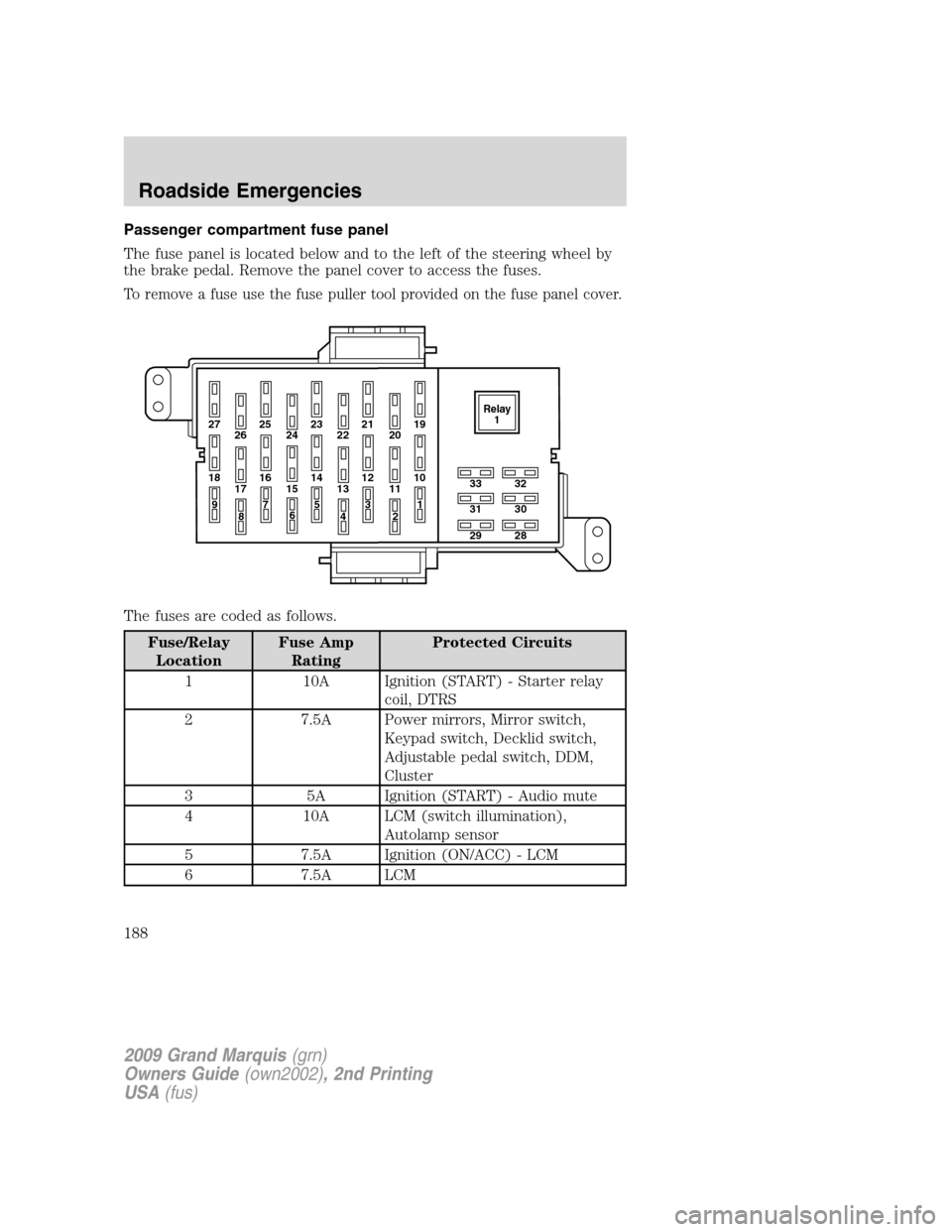
Passenger compartment fuse panel
The fuse panel is located below and to the left of the steering wheel by
the brake pedal. Remove the panel cover to access the fuses.
To remove a fuse use the fuse puller tool provided on the fuse panel cover.
The fuses are coded as follows.
Fuse/Relay
LocationFuse Amp
RatingProtected Circuits
1 10A Ignition (START) - Starter relay
coil, DTRS
2 7.5A Power mirrors, Mirror switch,
Keypad switch, Decklid switch,
Adjustable pedal switch, DDM,
Cluster
3 5A Ignition (START) - Audio mute
4 10A LCM (switch illumination),
Autolamp sensor
5 7.5A Ignition (ON/ACC) - LCM
6 7.5A LCM
27 25
26 2423 21
2219
20
18 16
17 1514 12
1310
33
31
2932
30
28 11
97
8653
41
2Relay
1
2009 Grand Marquis(grn)
Owners Guide(own2002), 2nd Printing
USA(fus)
Roadside Emergencies
188
Page 190 of 270
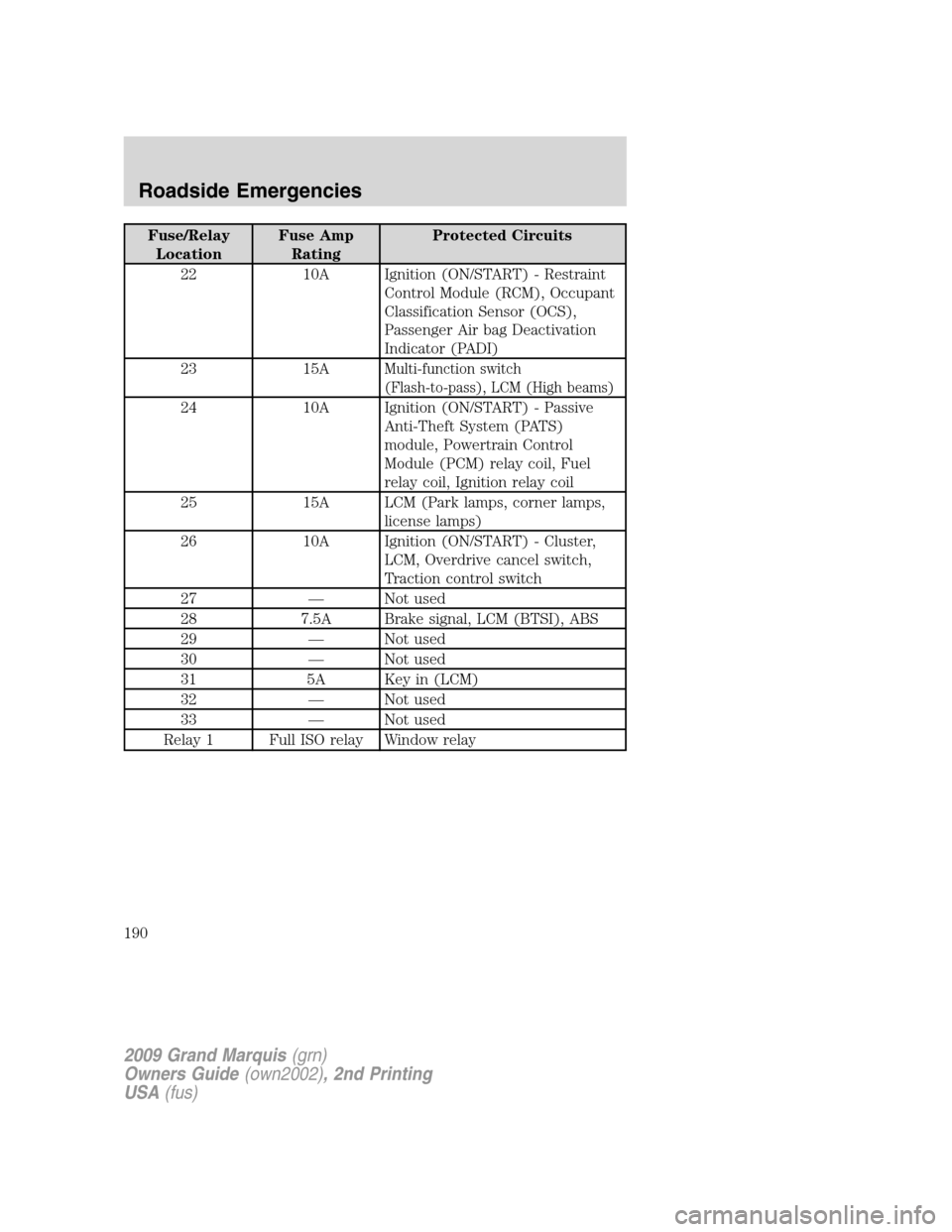
Fuse/Relay
LocationFuse Amp
RatingProtected Circuits
22 10A Ignition (ON/START) - Restraint
Control Module (RCM), Occupant
Classification Sensor (OCS),
Passenger Air bag Deactivation
Indicator (PADI)
23 15A
Multi-function switch
(Flash-to-pass), LCM (High beams)
24 10A Ignition (ON/START) - Passive
Anti-Theft System (PATS)
module, Powertrain Control
Module (PCM) relay coil, Fuel
relay coil, Ignition relay coil
25 15A LCM (Park lamps, corner lamps,
license lamps)
26 10A Ignition (ON/START) - Cluster,
LCM, Overdrive cancel switch,
Traction control switch
27 — Not used
28 7.5A Brake signal, LCM (BTSI), ABS
29 — Not used
30 — Not used
31 5A Key in (LCM)
32 — Not used
33 — Not used
Relay 1 Full ISO relay Window relay
2009 Grand Marquis(grn)
Owners Guide(own2002), 2nd Printing
USA(fus)
Roadside Emergencies
190
Page 192 of 270
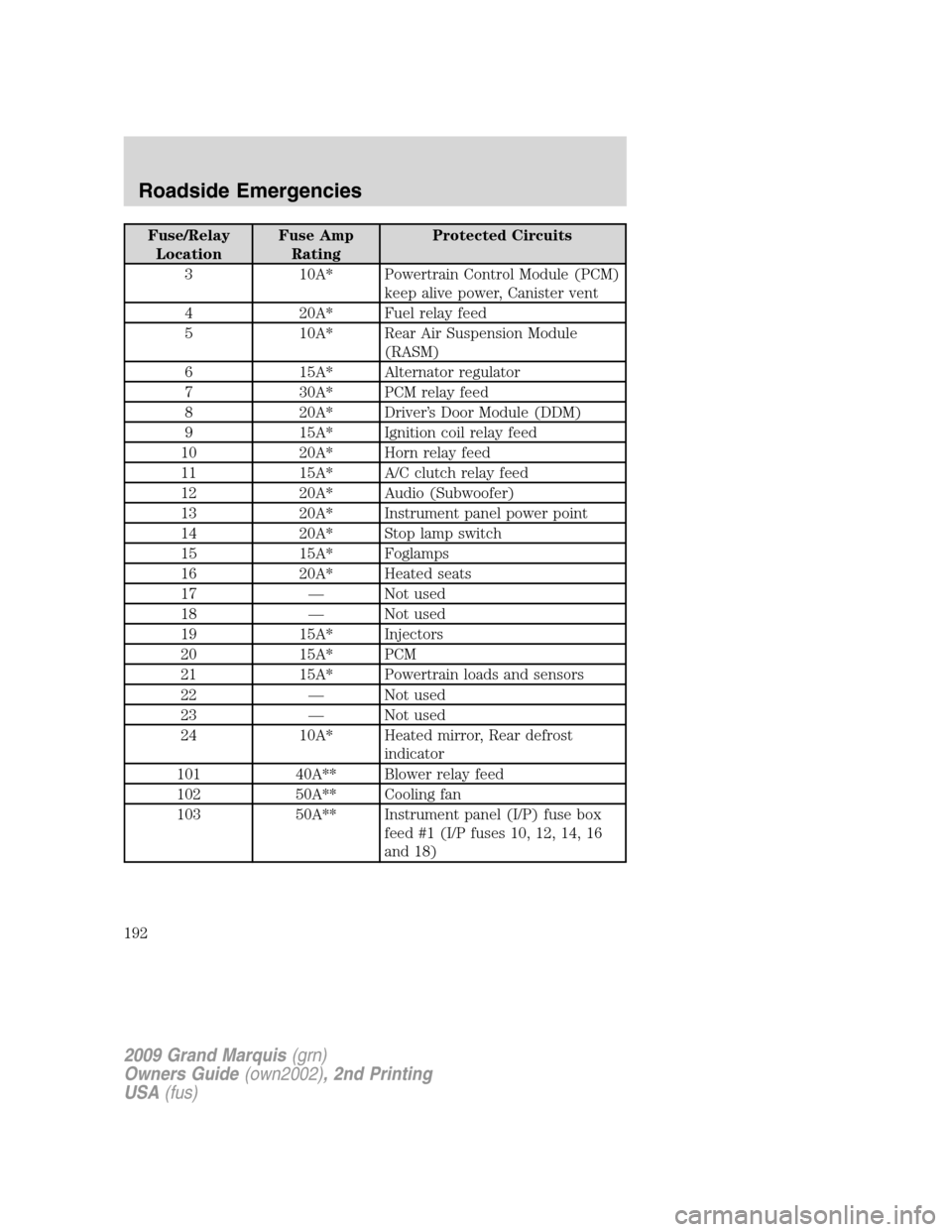
Fuse/Relay
LocationFuse Amp
RatingProtected Circuits
3 10A* Powertrain Control Module (PCM)
keep alive power, Canister vent
4 20A* Fuel relay feed
5 10A* Rear Air Suspension Module
(RASM)
6 15A* Alternator regulator
7 30A* PCM relay feed
8 20A* Driver’s Door Module (DDM)
9 15A* Ignition coil relay feed
10 20A* Horn relay feed
11 15A* A/C clutch relay feed
12 20A* Audio (Subwoofer)
13 20A* Instrument panel power point
14 20A* Stop lamp switch
15 15A* Foglamps
16 20A* Heated seats
17 — Not used
18 — Not used
19 15A* Injectors
20 15A* PCM
21 15A* Powertrain loads and sensors
22 — Not used
23 — Not used
24 10A* Heated mirror, Rear defrost
indicator
101 40A** Blower relay feed
102 50A** Cooling fan
103 50A** Instrument panel (I/P) fuse box
feed #1 (I/P fuses 10, 12, 14, 16
and 18)
2009 Grand Marquis(grn)
Owners Guide(own2002), 2nd Printing
USA(fus)
Roadside Emergencies
192
Page 194 of 270
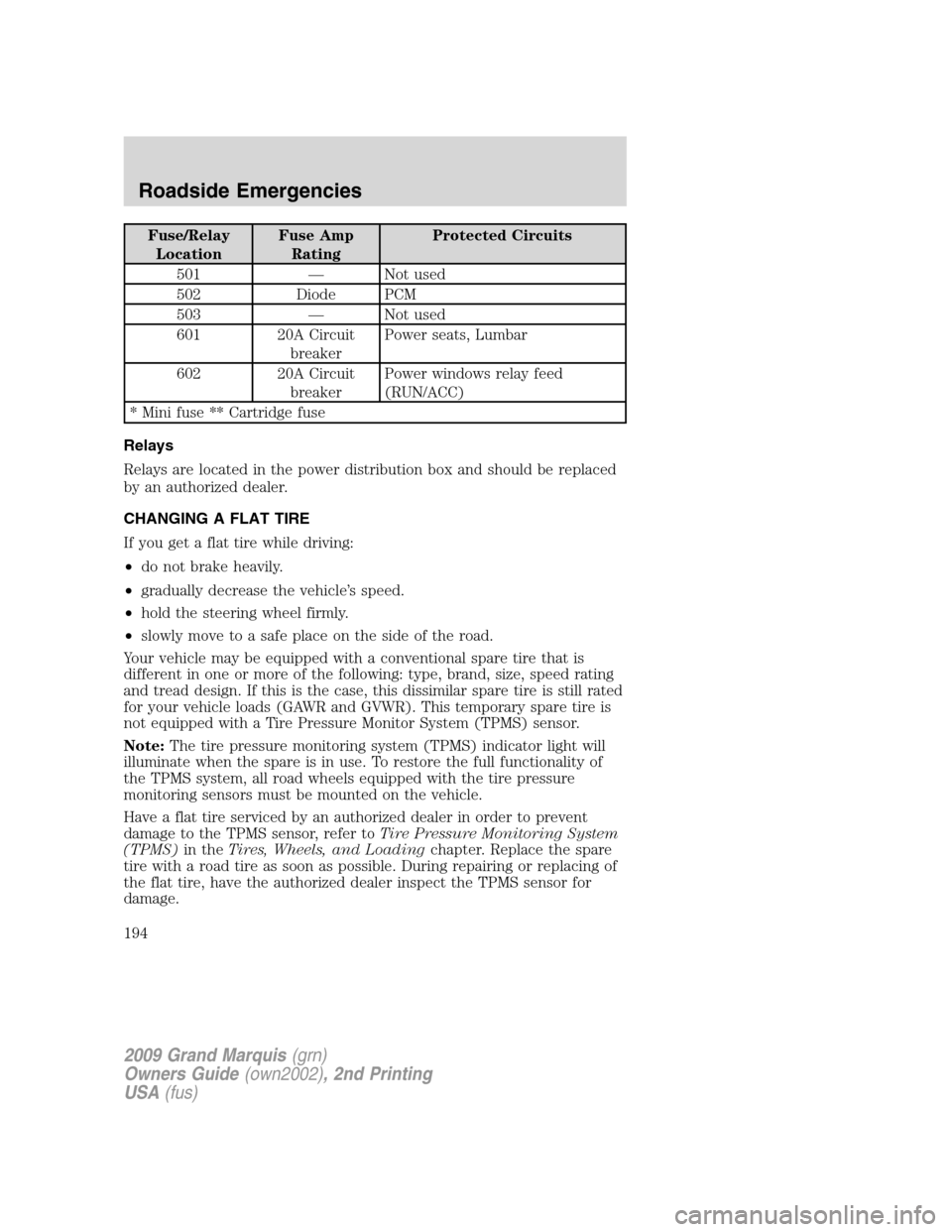
Fuse/Relay
LocationFuse Amp
RatingProtected Circuits
501 — Not used
502 Diode PCM
503 — Not used
601 20A Circuit
breakerPower seats, Lumbar
602 20A Circuit
breakerPower windows relay feed
(RUN/ACC)
* Mini fuse ** Cartridge fuse
Relays
Relays are located in the power distribution box and should be replaced
by an authorized dealer.
CHANGING A FLAT TIRE
If you get a flat tire while driving:
•do not brake heavily.
•gradually decrease the vehicle’s speed.
•hold the steering wheel firmly.
•slowly move to a safe place on the side of the road.
Your vehicle may be equipped with a conventional spare tire that is
different in one or more of the following: type, brand, size, speed rating
and tread design. If this is the case, this dissimilar spare tire is still rated
for your vehicle loads (GAWR and GVWR). This temporary spare tire is
not equipped with a Tire Pressure Monitor System (TPMS) sensor.
Note:The tire pressure monitoring system (TPMS) indicator light will
illuminate when the spare is in use. To restore the full functionality of
the TPMS system, all road wheels equipped with the tire pressure
monitoring sensors must be mounted on the vehicle.
Have a flat tire serviced by an authorized dealer in order to prevent
damage to the TPMS sensor, refer toTire Pressure Monitoring System
(TPMS)in theTires, Wheels, and Loadingchapter. Replace the spare
tire with a road tire as soon as possible. During repairing or replacing of
the flat tire, have the authorized dealer inspect the TPMS sensor for
damage.
2009 Grand Marquis(grn)
Owners Guide(own2002), 2nd Printing
USA(fus)
Roadside Emergencies
194
Page 195 of 270
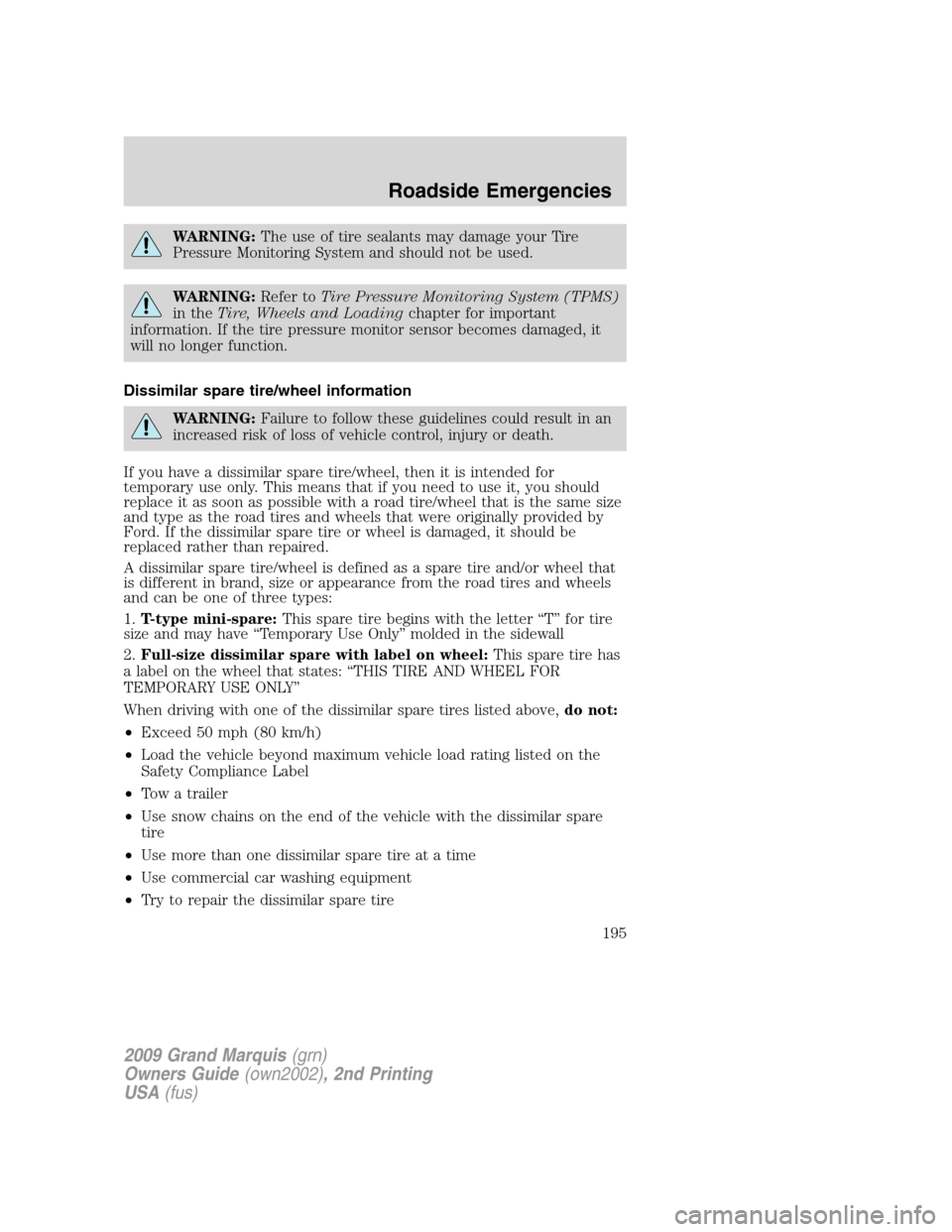
WARNING:The use of tire sealants may damage your Tire
Pressure Monitoring System and should not be used.
WARNING:Refer toTire Pressure Monitoring System (TPMS)
in theTire, Wheels and Loadingchapter for important
information. If the tire pressure monitor sensor becomes damaged, it
will no longer function.
Dissimilar spare tire/wheel information
WARNING:Failure to follow these guidelines could result in an
increased risk of loss of vehicle control, injury or death.
If you have a dissimilar spare tire/wheel, then it is intended for
temporary use only. This means that if you need to use it, you should
replace it as soon as possible with a road tire/wheel that is the same size
and type as the road tires and wheels that were originally provided by
Ford. If the dissimilar spare tire or wheel is damaged, it should be
replaced rather than repaired.
A dissimilar spare tire/wheel is defined as a spare tire and/or wheel that
is different in brand, size or appearance from the road tires and wheels
and can be one of three types:
1.T-type mini-spare:This spare tire begins with the letter “T” for tire
size and may have “Temporary Use Only” molded in the sidewall
2.Full-size dissimilar spare with label on wheel:This spare tire has
a label on the wheel that states: “THIS TIRE AND WHEEL FOR
TEMPORARY USE ONLY”
When driving with one of the dissimilar spare tires listed above,do not:
•Exceed 50 mph (80 km/h)
•Load the vehicle beyond maximum vehicle load rating listed on the
Safety Compliance Label
•Tow a trailer
•Use snow chains on the end of the vehicle with the dissimilar spare
tire
•Use more than one dissimilar spare tire at a time
•Use commercial car washing equipment
•Try to repair the dissimilar spare tire
2009 Grand Marquis(grn)
Owners Guide(own2002), 2nd Printing
USA(fus)
Roadside Emergencies
195
Page 268 of 270
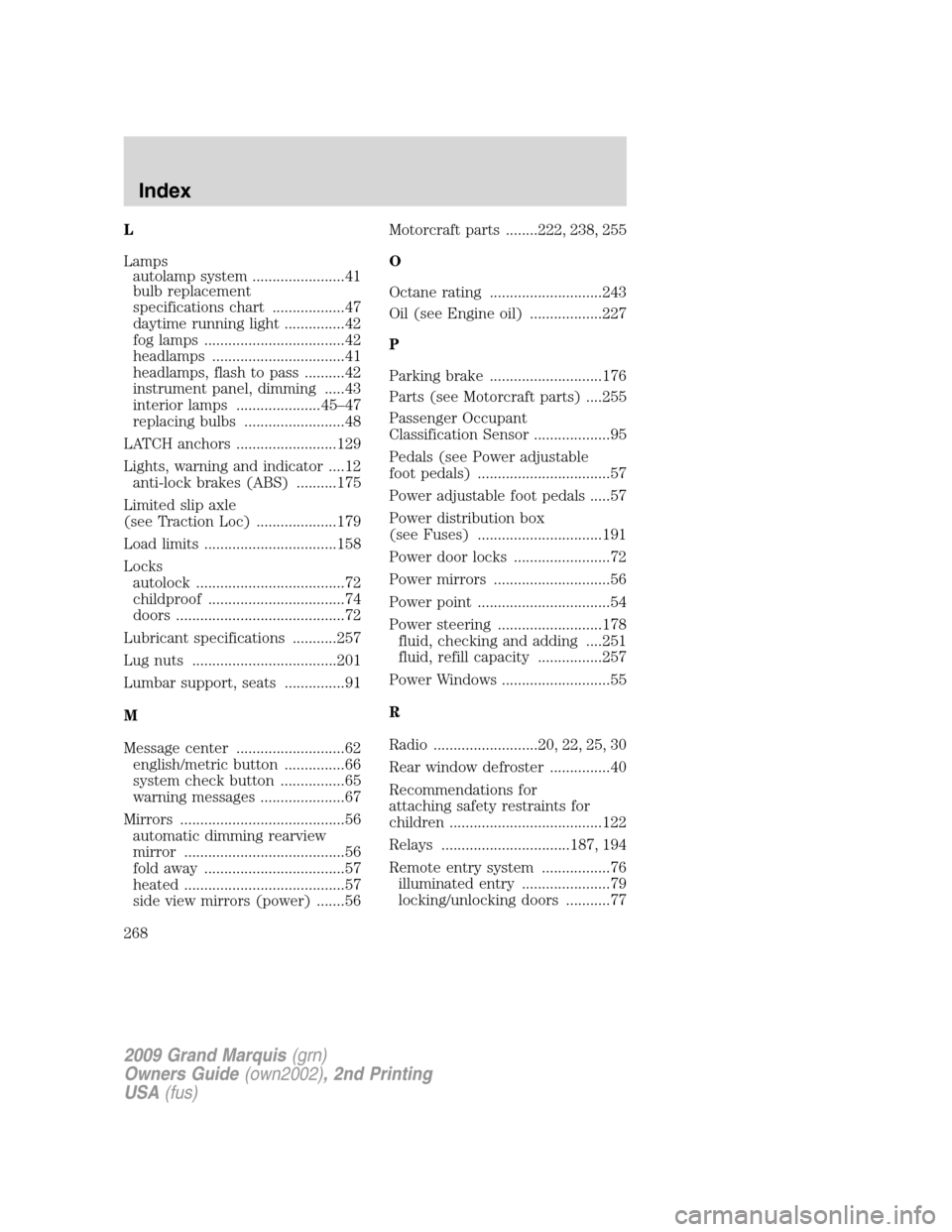
L
Lamps
autolamp system .......................41
bulb replacement
specifications chart ..................47
daytime running light ...............42
fog lamps ...................................42
headlamps .................................41
headlamps, flash to pass ..........42
instrument panel, dimming .....43
interior lamps .....................45–47
replacing bulbs .........................48
LATCH anchors .........................129
Lights, warning and indicator ....12
anti-lock brakes (ABS) ..........175
Limited slip axle
(see Traction Loc) ....................179
Load limits .................................158
Locks
autolock .....................................72
childproof ..................................74
doors ..........................................72
Lubricant specifications ...........257
Lug nuts ....................................201
Lumbar support, seats ...............91
M
Message center ...........................62
english/metric button ...............66
system check button ................65
warning messages .....................67
Mirrors .........................................56
automatic dimming rearview
mirror ........................................56
fold away ...................................57
heated ........................................57
side view mirrors (power) .......56Motorcraft parts ........222, 238, 255
O
Octane rating ............................243
Oil (see Engine oil) ..................227
P
Parking brake ............................176
Parts (see Motorcraft parts) ....255
Passenger Occupant
Classification Sensor ...................95
Pedals (see Power adjustable
foot pedals) .................................57
Power adjustable foot pedals .....57
Power distribution box
(see Fuses) ...............................191
Power door locks ........................72
Power mirrors .............................56
Power point .................................54
Power steering ..........................178
fluid, checking and adding ....251
fluid, refill capacity ................257
Power Windows ...........................55
R
Radio ..........................20, 22, 25, 30
Rear window defroster ...............40
Recommendations for
attaching safety restraints for
children ......................................122
Relays ................................187, 194
Remote entry system .................76
illuminated entry ......................79
locking/unlocking doors ...........77
2009 Grand Marquis(grn)
Owners Guide(own2002), 2nd Printing
USA(fus)
Index
268